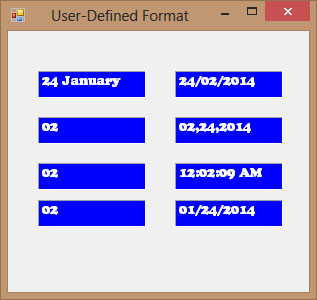The Format function is used to display numbers as well as date and time in various formats.
There are two types of Format functions, the built-in format function, and the user-defined function.
The syntax of a built-in Format function is
Format (n, “style argument”)
The list of style arguments in Visual Basic 2013 is given in Table 19.1.
| Style argument | Explanation | Example |
|---|---|---|
| General Number | To display the number without having separators between thousands. | Format(8972.234, "General Number")=8972.234 |
| Fixed | To display the number without having separators between thousands and rounds it up to two decimal places. | Format(8972.2, "Fixed")=8972.23 |
| Standard | To display the number with separators or separators between thousands and rounds it up to two decimal places. | Format(6648972.265, "Standard")= 6,648,972.27 |
| Currency | To display the number with the dollar sign in front has separators between thousands as well as rounding it up to two decimal places. | Format(6648972.265, "Currency")= $6,648,972.27 |
| Percent | Converts the number to the percentage form and displays a % sign and rounds it up to two decimal places. | Format(0.56324, "Percent")=56.32 % |
Private Sub BtnFormat_Click(sender As Object, e As EventArgs) Handles BtnFormat.Click Label1.Text = Format(8972.234, "General Number") Label2.Text = Format(8972.2, "Fixed") Label3.Text = Format(6648972.265, "Standard") Label4.Text = Format(6648972.265, "Currency") Label5.Text = Format(0.56324, "Percent") End Sub

The syntax of the user-defined Format function is
Format (n, “user’s format”)
Although it is known as user-defined format, we still need to follows certain formatting styles. Examples of user-defined formatting style are listed in Table 19.2
| Format | Description | Output |
|---|---|---|
| Format(781234.576,"0") | Rounds to whole number without separators between thousands | 781235 |
| Format(781234.576,"0.0") | Rounds to 1 decimal place without separators between thousands | 781234.6 |
| Format(781234.576,"0.00") | Rounds to 2 decimal place without separators between thousands | 781234.58 |
| Format(781234.576,"#,##0.00") | Rounds to 2 decimal place with separators between thousands | 781,234.58 |
| Format(781234.576,"$#,##0.00") | Displays dollar sign and Rounds to 2 decimal place with separators between thousands | $781,234.58 |
| Format(0.576,"0%") | Converts to percentage form without decimal place | 58% |
| Format(0.5768,"0%") | Converts to percentage form with two decimal places | 57.68% |
Private Sub BtnFormat_Click(sender As Object, e As EventArgs) Handles BtnFormat.Click Label1.Text = Format(8972.234, "0.0") Label2.Text = Format(8972.2345, "0.00") Label3.Text = Format(6648972.265, "#,##0.00") Label4.Text = Format(6648972.265, "$#,##0.00") Label5.Text = Format(0.56324, "0%") End Sub
There are two types of Format functions for Date and time one of them is the built-in or predefined format while another one can be defined by the user.
In Visual Basic 2013, we can format date and time using predefined formats or user-defined formats. The predefined formats of date and time are shown in Table 19.3
| Format | description |
|---|---|
| Format(Now, "General Date") | Displays current date and time |
| Format(Now, "Long Date") | Displays current date in long format |
| Format (Now, “Short date”) | Displays current date in short format |
| Format (Now, “Long Time”) | Displays current time in long format. |
| Format (Now, “Short Time”) | Displays current time in short format. |
Private Sub BtnDisplay_Click(sender As Object, e As EventArgs) Handles BtnDisplay.Click Label1.Text = Format(Now, "General Date") Label2.Text = Format(Now, "Long Date") Label3.Text = Format(Now, "short Date") Label4.Text = Format(Now, "Long Time") Label5.Text = Format(Now, "Short Time") End Sub
You can display dates and time in real-time using a timer and set its property Enabled to true and interval 100. The code is as follows:
Private Sub Timer1_Tick(sender As Object, e As EventArgs) Handles Timer1.Tick Label1.Text = Format(Now, "General Date") Label2.Text = Format(Now, "Long Date") Label3.Text = Format(Now, "short Date") Label4.Text = Format(Now, "Long Time") Label5.Text = Format(Now, "Short Time") End Sub19.2(b) Formatting Date and time using user-defined formats
Besides using the predefined formats, you can also use the user-defined formatting functions. The syntax of a user-defined format for date and time is
Format (expression,style)
| Format | Description |
|---|---|
| Format (Now, “m”) | Displays current month and date |
| Format (Now, “mm”) | Displays current month in double digits. |
| Format (Now, “mmm”) | Displays abbreviated name of the current month |
| Format (Now, “mmmm”) | Displays full name of the current month. |
| Format (Now, “dd/mm/yyyy”) | Displays current date in the day/month/year format. |
| Format (Now, "mmm,d,yyyy") | Displays current date in the Month, Day, Year Format |
| Format (Now, "h:mm:ss tt") | Dispalys current time in hour:minute:second format and show am/pm |
| Format (Now, "MM/dd/yyyy h:mm:ss) | Dispalys current date and time in hour:minute:second format |
Private Sub Timer1_Tick(sender As Object, e As EventArgs) Handles Timer1.Tick Label1.Text = Format(Now, "m") Label2.Text = Format(Now, "mm") Label3.Text = Format(Now, "mmm") Label4.Text = Format(Now, "mmmm") Label5.Text = Format(Now, "dd/mm/yyyy") Label6.Text = Format(Now, "mmm,d,yyyy") Label7.Text = Format(Now, "h:mm:ss tt") Label8.Text = Format(Now, "MM/dd/yyyy h:mm:ss tt") End Sub

Copyright©2008 Dr.Liew Voon Kiong. All rights reserved |Contact|Privacy Policy